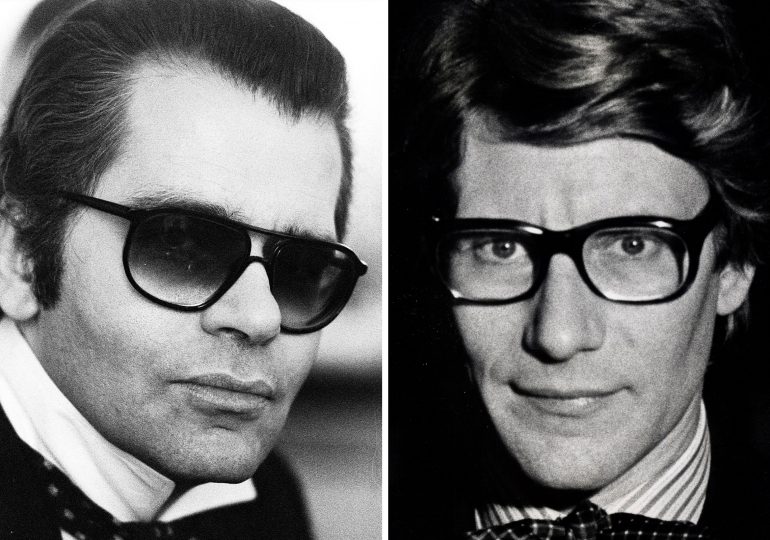Becoming Karl Lagerfeld, a limited series which debuts on Hulu today (June 7), examines the life and career of the controversial German fashion designer before he became a household name as the creative director of Chanel, a position he held for 36 years. One of the overarching tensions in the show is Lagerfeld’s professional rivalry with his friend-turned-frenemy, the French couturier Yves Saint Laurent, which turns intensely personal after Saint Laurent begins a brief but passionate affair with Lagerfeld’s romantic partner, the French dandy Jacques de Bascher.
[time-brightcove not-tgx=”true”]
Read more: How Karl Lagerfeld Redefined Modern Fashion As We Know It
In real life, this juicy love triangle sent tongues wagging across the industry and high society during the 1970s and escalated a seemingly friendly competition between Lagerfeld and Saint Laurent, who had come up together as young designers in the Paris fashion scene, into a bitter rivalry, effectively ending their friendship.
Here’s what you need to know about the scandalous real-life love triangle that inspired Becoming Karl Lagerfeld.
Were Karl Lagerfeld and Yves Saint Laurent friends?
For the majority of their careers, Lagerfeld and Saint Laurent, both titans of French fashion, were foils to one another. These two immensely different talents and their competition with one another helped define not only fashion, but what it meant to be a fashion designer in the 20th century. Their parallel journeys began in 1954 when both designers, Lagerfeld, then 21, and Saint Laurent, then 18, entered the prestigious International Wool Secretariat (now known as the International Woolmark prize) design competition in Paris. While Lagerfeld won first prize in the coat category, Saint Laurent nabbed the highest distinction, taking home the top honors in the evening gown category.
Following their respective wins, their journeys in fashion took drastically different paths. Saint Laurent was catapulted to nearly immediate prominence as a design wunderkind when he was hired by Christian Dior and shortly afterwards, appointed as his replacement at the fashion house after Dior’s unexpected death in 1957. Saint Laurent left this post to serve in the French army after he was drafted in 1960 during the Algerian War, during which time he was fired from Dior. Following his release from the army, he successfully sued Dior for breach of contract and founded his namesake design house in 1961, finding immense success in the 70s and 80s, where his sexy and glamorous designs like the iconic “Le Smoking” women’s tuxedo jacket helped capture the opulence and cultural shifts of the time. The glittering allure of Saint Laurent’s designs were heightened by his aura as a public figure; he was noted for his entourage of cosmopolitan muses and friends, and his affinity for partying, decadence and debauchery.
During this time, Lagerfeld cut a much more low-key figure. Following his Woolmark win, he designed for French fashion designers Balmain and Jean Patou, then freelanced for fashion houses like Charles Jourdan, Valentino, Chloé, and Fendi. Both Chloé and Fendi were influential in developing his career. Lagerfeld began designing for Fendi in 1965, when he was recruited to work on their fur line; he would later design its signature double F logo, help launch its ready-to-wear line and creatively helmed the brand until his death in 2019. His career at Fendi overlapped with his more prominent work for Chanel and other houses.
Lagerfeld also began freelancing for Chloé in 1964, where he became a designer in 1966, later taking on the role of sole designer 1974, a position he held until 1983 (although he returned for another stint at Chloé from 1992-1997). His first departure from Chloé came after he was appointed artistic director at Chanel in 1982, his most high-profile gig to date and the position that would win him worldwide acclaim in the fashion world and beyond. Though Lagerfeld launched his eponymous brand in 1984, it never took priority when it came to his design. And unlike Saint Laurent, whose indulgences embodied the vices of the time, Lagerfeld was known for avoiding drugs and alcohol, his stringent discipline when it came to work ethic, as well as his emotional reticence and sharp tongue.
Though the two designers were ostensibly in competition with one another, at one point they were friendly—or at the very least, frenemies. In The Beautiful Fall: Lagerfeld, Saint Laurent, and Glorious Excess in 1970s Paris, author Alicia Drake relays a scathing interview that Lagerfeld gave to a French magazine where he compares the Saint Laurent of the 1980s to the one he once knew.
“That particular Yves I don’t like because I know another one. He is one of the funniest people alive, with an incredible sense of humor, who can do unbelievable impressions…who loved to use swear words and loved anything scatological…who was really very funny,” he said. “It is an absurd idea when he says that he didn’t have a youth. I knew him myself when he had one, but he only had one desire at the time…to be rich and famous.”
Who was Jacques de Bascher?
Jacques de Bascher was an Air France steward from an aristocratic family who became one of France’s most notorious playboys after he met Lagerfeld at a club in Paris in 1971, soon afterwards becoming his romantic partner. Though he is portrayed in Becoming Karl Lagerfeld as an aspiring writer, in real life, de Bascher was more well known for being a member of the jet set, his many lascivious affairs, and his vice-fueled parties. Known for his champagne tastes and boundless appetites, de Bascher reportedly kept his silk ties in a ribbon box that once belonged to Marie Antoinette and lived a life of luxury funded by Lagerfeld.
In Marie Ottavi’s biography of de Bascher, Jacques de Bascher, Dandy de l’ombre (“Jacques de Bascher, Shadow Dandy,”) Lagerfeld was frank about his deep affection for de Bascher, despite their starkly different lifestyles and interests.
“He was the person who amused me more than anyone,” Lagerfeld said. “He was also impossible, despicable — he was perfect…I’m a total puritan, but I found Jacques’ adventures amusing. We couldn’t be further apart. I am a Calvinist toward myself, and totally indulgent toward others.”
Lagerfeld’s deep care for de Bascher was evident in his acceptance of de Bascher’s messy affair in 1974 with Saint Laurent. In the Lagerfeld biography Paradise Now, author William Middleton reveals that the affair, though passionate, was just six months long and cut short by Saint Laurent’s business partner and former romantic partner, Pierre Bergé, who blamed de Bascher and Lagerfeld for Saint Laurent’s growing interest in hard drugs and sadomasochism, as well as his struggle with mental health.
For Lagerfeld, de Bascher was a rare exception to the severity that ruled the rest of his life. Despite de Bascher’s many affairs, Lagerfeld, who could be notoriously unforgiving, cared for him deeply as a partner, remaining a constant in his life until de Bascher’s death at 35 in 1989 from AIDS. For context, consider what the late André Leon Talley wrote in his 2019 obituary for Lagerfeld in Vogue: “Karl was extravagant, generous, and very, very kind to his friends, until he had a rupture; then he would simply delete one from his life, cutting all lines of communication with no explanation.” When de Bascher tested positive for HIV in 1984, Lagerfeld provided the best doctors and medical care, going so far as to sleep in a cot in his room once de Bascher was hospitalized indefinitely.
“He was the only thing that gave a kind of sense to things,” Lagerfeld said in a 1992 interview with Vanity Fair, three years after de Bascher’s death. “He brought to my life a kind of sparkle nobody else ever will. Maybe there is one person in life for you and that’s all.”
What did Lagerfeld have to say about the affair with Saint Laurent?
In Ottavi’s book, Lagerfeld addresses his partner’s affair with Saint Laurent with surprising candor and blamed Bergé, Saint Laurent’s business partner, for any ensuing animosity between him and Saint Laurent.
“Of course I knew about the affair with Saint Laurent,” he said. “I had been close friends with Yves for more than 20 years. We used to go out in the early days with Anne-Marie Munoz and Victoire Doutreleau. Pierre smashed that to bits. He said I engineered their liaison to destabilize the house of Saint Laurent.”
In a 2024 interview with El País, Ottavi elaborated on the bad blood between Lagerfeld and Bergé.
“Lagerfeld and Bergé started out as friends,” she said. “They shared Bergé’s love of books, but their relationship deteriorated over time. Bergé saw Yves Saint Laurent as an artist and a genius, but not Lagerfeld. And he made him feel that way. He also despised his German roots, in contrast to Yves’s French taste. Karl told me that he felt that his friendship with Yves had been destroyed by Bergé and that he probably played a role in his estrangement from him. For Bergé, there was only one place at the top of the pyramid…and it was for Yves.”
In Ottavi’s book, Lagerfeld also showed uncharacteristic gentleness while talking about de Bascher’s many romantic entanglements.
“I didn’t hold him accountable,” Lagerfeld said. “I only wanted to see the bright side of Jacques. I was unaware of what he kept in the shadows. He would tell me about what he did when I wasn’t around, but I didn’t ask questions.”
Leave a comment








